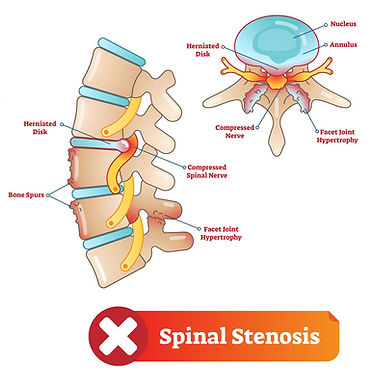1100 Joliet St
Suite 104
Dyer, IN 46311

The term “stenosis” comes from Greek and means a “choking”. Spinal stenosis, however, has little in common with choking. Lumbar stenosis can cause symptoms of sciatic pain. There are two primary types of spinal stenosis:
• In lumbar spinal stenosis, the spinal nerve roots in the lower back are compressed, or choked, and this can produce symptoms of sciatic pain — tingling, weakness or numbness that radiates from the low back and into the buttocks and legs — especially with activity.
• Spinal stenosis in the neck (cervical stenosis) can be far more dangerous by
compressing the spinal cord itself and possibly leading to major body weakness or even paralysis. This is virtually impossible in the lumbar spine, however, as the spinal cord is not present in the lumbar spine.
An example of cervical spinal stenosis.

In rare cases, lumbar spinal stenosis can go no further than to produce severe persistent disabling pain and even weakness in the legs. Most cases, however, have pain that radiates into the leg(s) with walking, and that pain will be relieved with sitting. This is called claudication which can also be caused by circulatory problems to the legs.
Spinal stenosis is related to degeneration in the spine and usually will become significant in the 5th decade of life and extend throughout every subsequent age group. Most patients first visit their doctor with symptoms of spinal stenosis at about age 60 or so. Patients need only seek treatment for lumbar spinal stenosis if they no longer wish to live with significant activity
limitations, such as leg pain and/or difficulty with walking.

The symptoms of lumbar spinal stenosis are often characterized as follows:
-
Develop slowly over time
-
May come and go, as opposed to continuous pain
-
Occurs during certain activities (such as walking) and/or positions (such as standing upright)
-
Relieved by rest (sitting or lying down) and/or any flexed forward position
In the neck (cervical spine)
-
Numbness or tingling in a hand, arm, foot or leg
-
Weakness in a hand, arm, foot or leg
-
Problems with walking and balance
-
Neck pain
In the lower back (lumbar spine)
-
Numbness or tingling in a foot or leg
-
Weakness in a foot or leg
-
Pain or cramping in one or both legs when you stand for long periods of time or when you walk, which usually eases when you bend forward or sit
-
Back pain
To learn more about this condition, download the printable PDF
